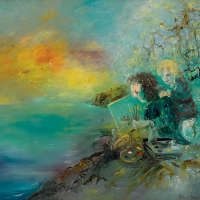53. DAVID BOYD

David Boyd was a prolific artist of extraordinary skill, compassion and humanity. Born in Melbourne in 1924 to artists Doris (1888-1960) and Merric Boyd (1888-1959), whom this painting depicts, he grew up in a milieu of gifted artists where he learned creative skills, including pottery, painting, music, etching and writing, virtually by osmosis. He continued this tradition of combining artistic creation and family with his wife Hermia (1931-2000), making some of the best pottery of modern times together for over a decade from 1946 to 1961.1
Rising to eminence as a painter in the late 1950s as a member of the celebrated Antipodeans (alongside his older brother Arthur Boyd (1920-1999), John Brack (1920-1999), Charles Blackman (1928-2018), Robert Dickerson (1924-2015), Clifton Pugh (1924-1990), John Perceval (1923-2000), and Bernard Smith (1916-2011)) he was dedicated to figurative painting in the face of abstract expressionism. In 1961 he was stamped with a permanent mark of success as his painting Monoliths won the prestigious Italian Government Travelling Art Scholarship Award, which was won the previous year by Brett Whiteley (1939-1992), and before that by Sidney Nolan (1917-1992). In the same year he was included in the highly selective and renowned exhibition Recent Australian Painting at the Whitechapel Gallery in London.
A landmark of Boyds painting career was the retrospective exhibition of his works that was requested by the Commonwealth Institute in 1969, the same year that the present work was created. The exhibition was shown in London and Edinburgh and prompted historian and art critic Edwin Mullins to comment, David Boyd is among the very best painters in England and certainly the most powerful image maker.2
Boyds art explores ideas of Australian myth and history, often unveiling the darker parts of our national consciousness, such as our legal system (The Trial Series), the status of Indigenous Australians (The Tasmanians Series), or The Establishment (Church and State Series). His inspiration was primarily drawn from his humanity, resulting in a life-long fight against injustice using image making and painterly skills as his weapons. However, the present work is rather different from his vindictive judges or tortured Aboriginals, instead returning to his childhood and depicting his father in the act of painting in a dreamlike setting, with every possibility that the blonde boy could be David himself, watching and learning. In 1970 art critic Robert Campbell wrote of Boyds recent works:
We are presented with a group of romantic, and at times wildly lyrical, canvases, which show the artist released from his philosophic, often histrionic attitudes of the past. These paintings glow with an extraordinary feeling of sunset or moonlight and have qualities quite unpredicted in the artists earlier work.3
In The Painter on the Beach Boyd recalls his own enchanted and creative childhood and the wilderness where he and his siblings played. Both David and Arthur were deeply devoted to their father, Merric Boyd, whose artistic practice influenced them throughout their lives.4 Filled with tender sentiment, the present work stands as a tribute to Boyds father and mentor. The work is painted with a dreamlike beauty that expresses nostalgia for childhood in vivid contrasting colours, the opalescent sea and the fiery sky clashing brilliantly before the two figures. Art critic Frederick Rogers aptly described such works in the Sunday Mail in 1971 as:
full of imagery, full of innocence, full of fantasy and, above all, full of colour [Boyds work] refreshes the spirit while it delights the eye and stimulates the imagination an ideal combination of qualities for any artist to lay claim to.5
Footnotes
1. Benko, N., The Art of David Boyd, Lidums, Adelaide, 1973, p.10
2. Mullins, E., Sunday Telegraph, London, 1969, quoted from ibid, p.13
3. Campbell, R., quoted from ibid, p.145-146
4. Amadio, N., The Passionate Journey: David Boyd Retrospective, May Street Galleries, Sydney, 2004, p.11
5. Rogers, F., quoted from Benko, N., The Art of David Boyd, Lidums, Adelaide, 1973, p.166
Asta Cameron BA, MA (Art Curatorship)